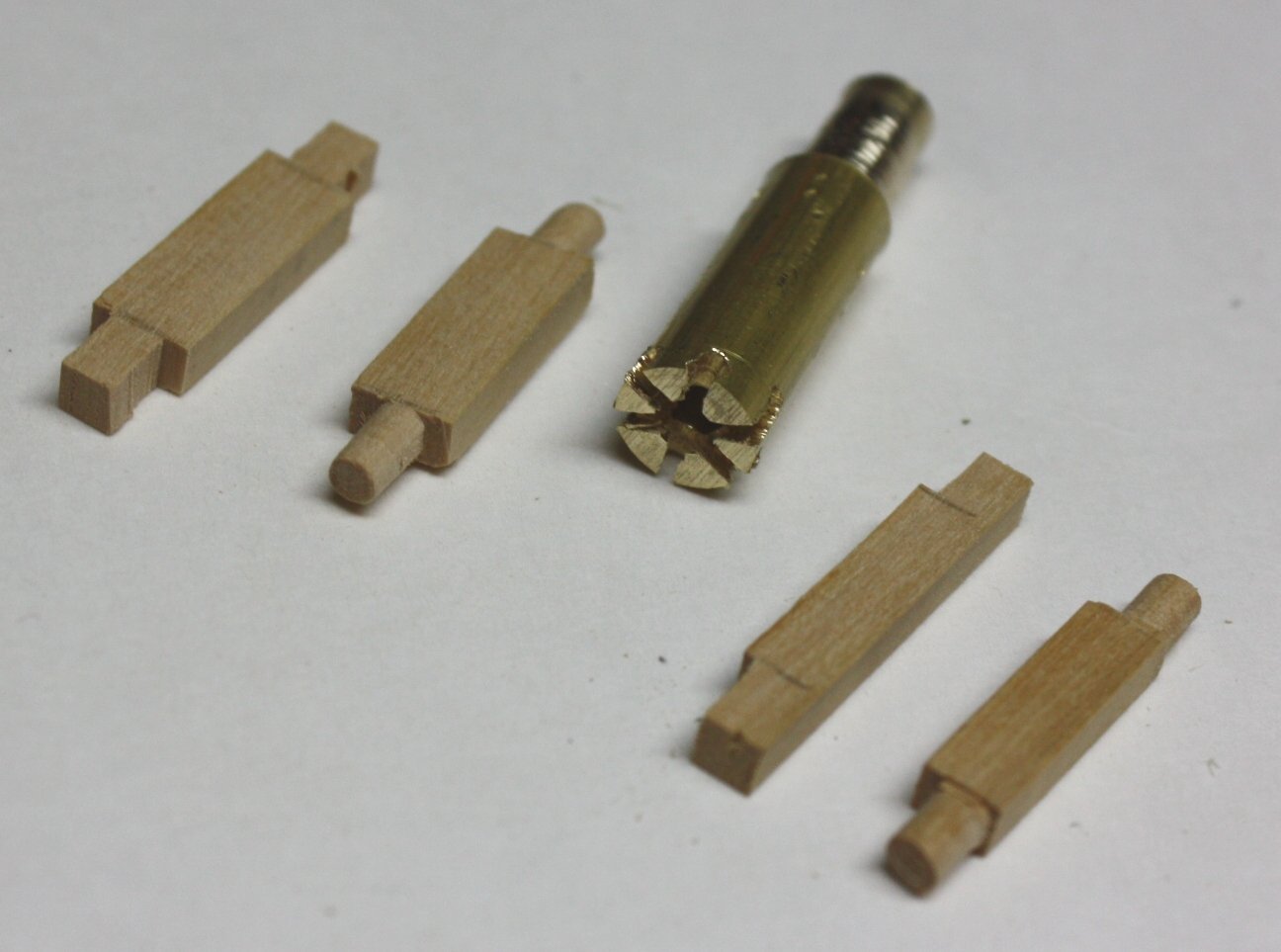-
Posts
8,125 -
Joined
-
Last visited
Content Type
Profiles
Forums
Gallery
Events
Posts posted by allanyed
-
-
-
The cannon drawings look great. Just noticed that you have the George II cypher on the cannon for Endeavour. I may be wrong but as Endeavour was launched in 1764, wouldn't the cypher be for George III? Armstrong Frederick STL drawings may be getting posted in the near future with the George III cypher in the following:
https://modelshipworld.com/topic/34442-3d-printing-cannons-in-resin/
There were recent discussions on the trucks having been made of single pieces so there were no bolts in them. There were many exceptions in ships so maybe some carpenter made truck assemblies rather than from single cylinders. https://modelshipworld.com/topic/34538-gun-carriage-questions/page/3/ Posts #66 and after.
Allan
-
Hi Andrew,
From the first photo of post #186 the slight light gap in the black rim of the truck on the left looks like a black band of paper or blackened copper or brass rather than char to me, but that may just be me.
Allan
-
-
Hi David,
Your work is truly well done, so this paragraph is meant only as a point of interest. When you have a few minutes, there was a lengthy discussion on trucks on the carriages. The conclusion SEEMS to be, based on contemporary sourced material, that trucks were not made in four pieces with bolts through them. https://modelshipworld.com/topic/34538-gun-carriage-questions/page/3/ It would be really interesting to know where Caldercraft came up with this idea of trucks made in pieces and iron rimmed, especially if they based it on contemporary sources. I never doubt that there were variations in many aspects of these ships of the past but after a lot of searching on this I have yet to find one picture of a relic or contemporary based drawing or written description that describes assembled trucks other than the use of iron bands on the rim on land based carriages. The iron would surely wear the deck planking and it would be far easier to replace a worn truck that had no iron rim than rip out the planking and replace it,
Allan
-
-
Don't forget to study the planking tutorials in the MSW Articles Data Base and Chuck Passaro's four part video on planking which may be more appropriate if your kit provides straight planks instead of spiled planks. It does not look like removing all those nails is going to be fun.😀
Allan
-
Hi David
Not sure if you have seen the below in other posts. It is hard to tell from the photos, but it looks like the axles are square rather than round. Not too late to easily round them with a little home made cutter. Just drill out the cutter stock piece to the diameter you want then cross cut a couple slots to give a cutting edge. Chuck the cutter in a small drill (press or hand drill) and it works easily, quickly and yields a much cleaner rod like protrusion than hand carving to round them.
Allan

- KARAVOKIRIS, AJohnson, DaveBaxt and 1 other
-
 4
4
-
-
-
Funniest story I have heard in a while, excellent story, excellent idea.
- DaveBaxt, mtaylor, thibaultron and 1 other
-
 4
4
-
Warm welcome to the motley crew Tim!
- Keith Black and mtaylor
-
 2
2
-
On 1/26/2024 at 4:42 PM, Lieste said:
The bore is the hollow, the sond of the bore is the deepest part of that hollow (a flat covering 11/12th of the bore radius in A/AF pattern, or the middle of a shallow ellipsoid in Blomefield and later pattern guns - according to Boxer at least - Some, such as carronades would have a deeper curve - in this case a hemisphere occupying half the typical nominal chamber length, with 'zero' length behind the sond (aside from the cascabel and breech face)).
Drawings please. It is far easier for some of us to understand the designs you are describing with drawings like the fantastic drawings that Ron has posted rather than using words only. Thanks again for your input. 😀
Allan
-
Welcome Phez!
Moving forward consider one or more of the very high quality starter kits designed by David Antscherl at Model Shipways to learn really good building techniques
https://modelexpo-online.com/Model-Shipways-Shipwright-3-Kit-Combo-Series_p_5465.html
Allan
- Keith Black and mtaylor
-
 2
2
-
7 hours ago, druxey said:
Be aware of the limited life of liver of sulphur. To be effective, it must be fresh.
I agree. My bottle is several years old or more and still good to go but it is sealed tight. But, when pouring a tiny amount into a small working jar and thinned down with water, it works great for a few hours, at most. If the small working jar is sealed tight as well it is good for some days, depending on how much it has be diluted with water. The nice thing is that an artist brush full of the raw LoS and equal amount of water in the small working jar is enough to coat a LOT of pieces. I also find that it is more forgiving on pieces of copper that are not as thoroughly cleaned as I would when using brass and Birchwood Casey and similar blackening agents. Once the pieces are cleaned, finger oils and such have not caused problems for the LoS on copper.
Allan
-
-
Hi Lieste
Sorry to repeat, but can you share where these instructions can be found and post drawings to help understand. For example, I cannot find what a sond is in relation to a cannon barrel anywhere on the internet, so far, or how Bavarian guns that you mention relate to AFs.
Many thanks for your help and input.
Allan
-
32 minutes ago, Lieste said:
The instructions for proportions are given for a 24pdr, and you should replace the proportion of 36/32, 29/32 and 20/32 for those three landmarks with the scale suitable to the calibre.
Hi Lieste
Can you share where these instructions can be found? Are they based on contemporary sources?
32 minutes ago, Lieste said:The proportion at the sond of the bore (and to the surface at the bore end)
I may be the only one not understanding what you are implying, but if you can you please post drawings of each (as Ron has done for all of us) to show what you mean, it would be appreciated.
Many thanks
Allan
- thibaultron and mtaylor
-
 2
2
-
Even after curing, exposure to sunshine and other UV light sources may cause the resin to weaken over time. To prevent this, you can seal the cannon and stop the resin from further reacting with UV light photons by using paint or any other type of UV blocker. I have used a matte clear with no problems.
Allan
- DaveBaxt, Thukydides, mtaylor and 2 others
-
 5
5
-
10 hours ago, gak1965 said:
Hopefully it will turn out okay, and I'll only have to add a little balsa or a couple of extra bulkheads rather than adding another 13 more to fill the gaps.
HI George
Whatever you can fair and will support the planking is a good way to go, be it fillers or more bulkheads. If this was a warship with many gun ports I would go with drawing and making double the number bulkheads, maybe more, depending on the spacing of the ports, but as this is not the case filler blocks seem like a great alternative.
Allan
- gak1965, mtaylor and Keith Black
-
 3
3
-
On 1/22/2024 at 9:35 PM, gak1965 said:
9 down, 5 to go
Just a thought based on experience...... I hope 14 bulkheads are enough to allow a smooth run of planking. With an overall length of 172 feet, the bulkheads at 1:72 will be about 2 inches apart so you will have huge gaps between each bulkhead. If you decide to go with more (28?) bulkheads the body plan with the station lines will be a great guide to drafting the additional pieces.
Allan
-
-
14 hours ago, oakheart said:
The drawing / painting looks more like a bevel than rounded.
Hi Tim,
A bit late now, but for the future, the forward edge of the completed rudder was not flat. If it was flat, the rudder could no be turned very much, if at all. There is a bearding piece on the forward edge of the rudder that was made of elm and had angles of 30 degrees from about 1650 to 1720. It was changed to 45 degree angles about 1720 to allow a wider turning arc when the rudder was hard over. There was a bearding piece on the after edge of the stern post with similar angles. (Peter Goodwin, The Construction and Fitting of the English Man of War, pp 129-30 ISBN 0-87021-016-5) He also has a chart showing the dimensions. Also, the rudder tapered, it was not the same thickness at the bottom as at the head. The taper of the rudder matches that of the stern post which can be found on the contemporary plans of Speedy 1828 at RMG Collections site. It appears to taper from about 10 inches thick at the head down to about 6 to 7 inches at the keel.
Allan
-
On 1/19/2024 at 7:43 PM, Lost and Confused said:
Black, Kiwi shoe polish with good success. good black color
If you are trying to simulate tarred standing rigging lines, it was dark brown, not black. You can buy Stockholm tar today, but I have no idea if it is like the Stockholm tar used in the age of sail. I do wonder if anyone has tried it on model standing rigging instead of dyes.
Allan





HMS Victory 1805 by kiwiron - Caldercraft - 1:72
in - Kit build logs for subjects built from 1751 - 1800
Posted · Edited by allanyed
Hi Ron,
Your model is really looking good. I really like how all of your gratings correctly have a solid periphery that will lay against the head ledges and coamings. I realize it may be an incorrect kit instruction, but I believe the battens on the gratings always lay fore and aft. Some in the photos are running athwartships.
Allan